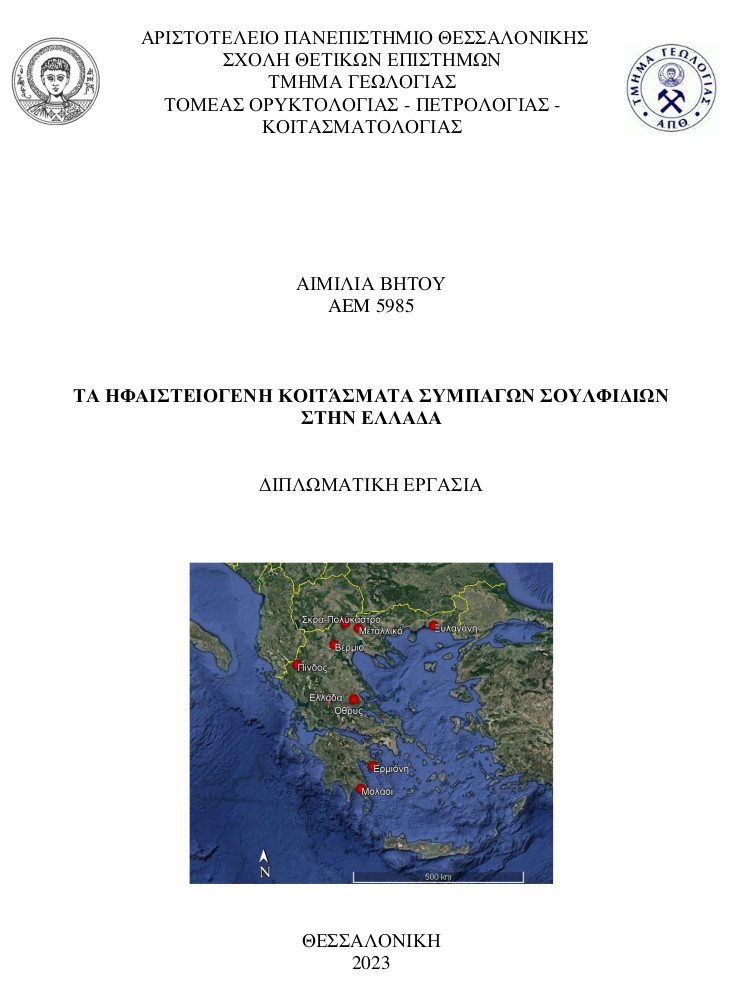
Τα Ηφαιστειογενή κοιτάσματα συμπαγών σουλφιδίων στην Ελλάδα = The Volcanogenic massive sulfide deposit in Greece.
Περίληψη
The present thesis aims to study the localized volcanic compact sulphides in Greece. Compact sulphide deposits associated with volcanism, also known as volcanogenic sulphides (VMS), are a category of "compact sulphide" deposits. Their main petrographic characteristics are iron pyrite, chalcopyrite, sphalerite, galena and, to a lesser extent, magnetite, tetrahedrite-tennantite, boronite, copper and/or silver. Also observed are the complex minerals: quartz, calcite, dolomite, ankerite, and there may be quantities of chlorite, sericite, barite and anhydrite. Depending on their chemical composition and the geotectonic environment of formation, four main types of deposits can be distinguished: the Cyprus type (Cu-silica) with gold, the Besshi type (Cu-Zn-Ag), the Kuroko type (Zn-Pb-Ag) and the Fe-Cu-Ni-Co type. The volcanogenic compact sulphide deposits in Greece are associated with submarine volcanism in ophiolitic complexes and important mineralisation is found in areas such as Vermio between Veroia-Naoussa, in Ermioni of Argolida, in Metaliko of Kilkis Prefecture, in the area of Molaoi, in the new Petra Xylagani, in Agioi Theodoroi of Mount Othrys, in Pindos and in Skra-Polykastro of Pikos.
Αναφορές
DIVI, S. R., THORPE, R.I. and FRANKLIN, J. M., (1979): Application of discriminant analysis to evaluate composition controls of stratiform massive sulphide deposits in Canada. Internat., Assoc. Mth. Geology, v. 11, no 4 p. 391-406.
DIVI, S. R., THORPE, R.I. and FRANKLIN, J. M., (1980): Use of discriminant analysis to evaluate compositional controls for stratiform massive sulfide deposits in Canada. Canada Geol. survey Paper 79-20, 23 p.
ELIOPOULOS, D. G., ECONOMOU-ELIOPOULOS, M., ECONOMOU, G., & SKOUNAKIS, V. (2020). Mineralogical and Geochemical Constraints on the Origin of Mafic–Ultramafic-Hosted Sulphides: The Pindos Ophiolite Complex. Minerals, 10(5), 454.
FERRARIO, A. and GARUTTI, G., (1980): Copper deposits in the basal breccias and volcano-sedimentary sequences of the eastern Ligurian ophiolities (Italy): Mineralium Deposita, v. 15, p. 291-303.
HUTCHINSON, R.W., (1973a): Volcanogenic sulfide deposits and their metallogenic significance. Econ. Geol. v. 68, p. 1223-1246.
KAPSIOTIS, A., ECONOMOU-ELIOPOULOS, M., ZHENG, H., HUANG, Q., LENAZ, D., ANTONELOU, A., ... & XIA, B. (2021). Metallogeny of a base metal sulfide-bearing magnetitite body from the Eretria mine, East Othris massif, Greece: Insights into an ancient seafloor hydrothermal system. Journal of Geochemical Exploration, 221, 106703.
KLAU, W., and LARGE, D.E., (1980): Submarine exhalative Cu-Pb-Zn deposits, a discussion of their classification and metallogenesis. Geol. Jahrbuch, sec. D, no 40, p 13-58.
MICHALLIDIS K.M., M.K. NIMFOPOULOS , A.CHATZIKIRKOU AND D.FOSTOUKOS: Fluid inclusion and stable isotope data of the base metal fluorite and barite veins in the Metallikon area, Macedonia, Northern Greece
LAMBERT, I.B. and SATO, T., (1974): The Kuroko and associated ore deposits of Japan: A review of their features and metallogenesis: Econ. Geol, v. 69, p. 1215-1286.
ROBERTSON, A. H. F., & VARNAVAS, S. P. (1993). The origin of hydrothermal metalliferous sediments associated with the Early Mesozoic Othris and Pindos ophiolites, mainland Greece. Sedimentary geology, 83(1-2), 87-113.
ROBERTSON, A. H. F., VARNAVAS, S. P., & PANAGOS, A. G. (1987). Ocean ridge origin and tectonic setting of Mesozoic sulphide and oxide deposits of the Argolis Peninsula of the Peloponnesus, Greece. Sedimentary geology, 53(1-2), 1-32.
ROCKFIRE RESOURCES PLC (2022). Outstanding metallurgical results from Molaoi.
SANGSTER, D.F. & SCOTT, S.P., (1976): Precambrian stratabound massive Cu-Zn-Pb sulfide ores of North America, in Wolf K.H. Hardbook of strafabound and stratiform ore deposits: Amsterdam, Elsevier p. 129-222.
SAWKINS, F.J., (1976): Massive sulphide deposits in relation to geotectonics: Geol. Assoc. Canada Spec. Paper 14, p. 221-240.
SKARPELIS, N. (2020). Setting, sulfur isotope variations, and metamorphism of Jurassic massive Zn‐Pb‐Ag sulfide mineralization associated with arc‐type volcanism (Skra, Vardar zone, Northern Greece). Resource Geology, 70(4), 311-335.
SOLOMON, M., (1976): "Volcanic" massive sulphide deposits and their host rocks- a review and an exploration, in Wolf K.A. ed, Hardbook of stratabound and stratiform ore deposits II Regional studies and specific deposits: Amsterdam Elsevier, p. 21-50.
SPOONER, E.T.C. & BRAY, C.J., (1977): Hydrothermal fluids of seawater salinity in ophiolitic sulphide ore deposits in Cyprus. Nature, 266: 808-812.
SPOONER, E.T.C. and FYTE, W.S., (1973): Sub-sea floor metamorphism heat and mass transfer. Cont. Mineralogy, Petrology, v. 42, p. 287-304.
TRIANTAFYLLIDIS, S., TOMBROS, S. F., ZHAI, D., & KOKKALAS, S. (2021). The Upper Cretaceous Ermioni VMS Deposit, Argolis Peninsula, Peloponnese, Greece: Type, genesis, and geotectonic setting. Ore Geology Reviews, 138, 104403.
ZUFFARDI, P., (1977): Ore mineral deposits related to the Mesozoic ophiolites in Italy in Lemm. O. D, and Schreider H.-J., (eds). Time and strata-bound ore deposits: New York Springer-Verlag., p. 314-326.
ΑΓΓΕΛΟΠΟΥΛΟΣ, Κ., & ΚΩΝΣΤΑΝΤΙΝΙΔΗΣ, Δ. (1988). Το κοίτασμα ψευδαργύρου-αργύρου-μολύβδου των Μολάων Λακωνίας. Δελτίον της Ελληνικής Γεωλογικής Εταιρίας, 20(2), 305-320.
ΕΜΜΑΝΟΥΗΛΙΔΗΣ, Χ. Β. (2019). Μεταλλογένεση της μεταξύ Βεροίας και Ναούσης περιοχής= Metallogenesis in the area between Veroia and Naousa. Προ/Μεταπτυχιακές Διατριβές στη βιβλιοθήκη Θεόφραστος του Τμήματος Γεωλογίας του ΑΠΘ.
ΜΕΛΦΟΣ, Β., & ΒΟΥΔΟΥΡΗΣ, Π. (2022). Κοιτάσματα της Ελλάδας.
ΜΙΧΑΗΛΙΔΗΣ, Κ. Κ., ΒΑΒΕΛΙΔΗΣ, Μ. Κ., & ΤΣΑΜΑΝΤΟΥΡΙΔΗΣ, Π. (1990). Framboidal μορφή σιδηροπυρίτη σε βιτουμενιούχους πυριτικούς σχιστόλιθους της ηφαιστειοϊζηματογενούς σειράς στην περιοχή Σκρα του νομού Κιλκίς (Β. Ελλάδα)= Framboidal pyrite in the bitumenous chert schists of the volcanosedimentary series from the Skra ar. Δελτίον της Ελληνικής Γεωλογικής Εταιρίας, 22, 159-170.
Εισερχόμενη Αναφορά
- Δεν υπάρχουν προς το παρόν εισερχόμενες αναφορές.
